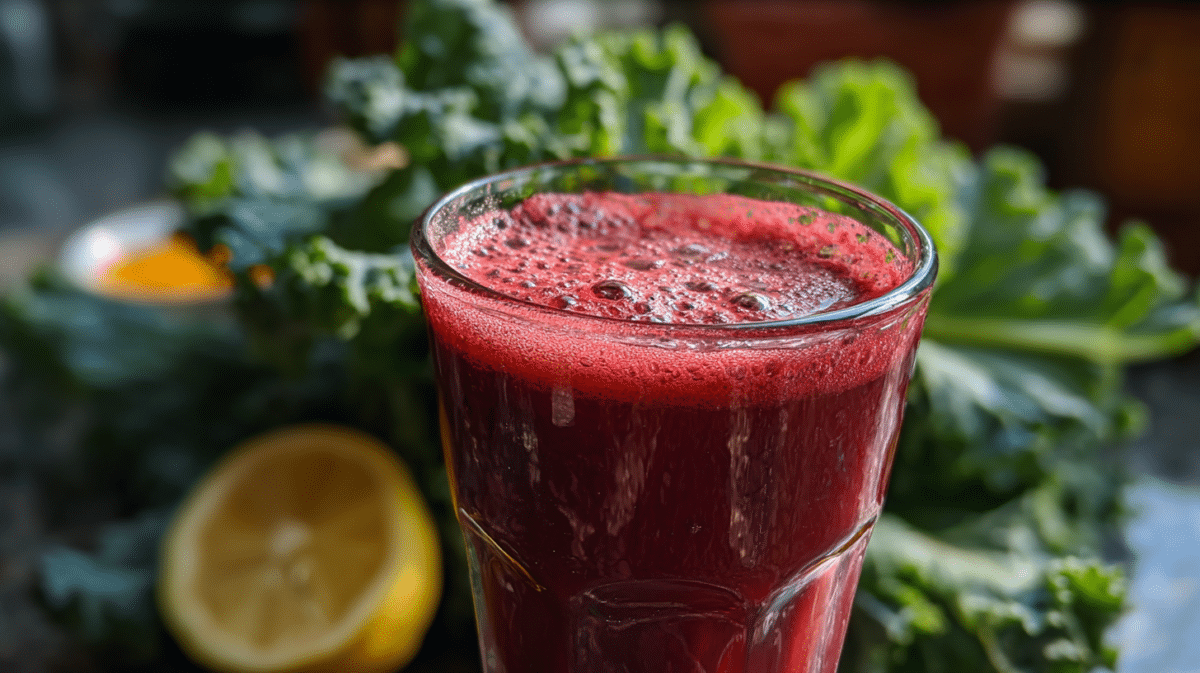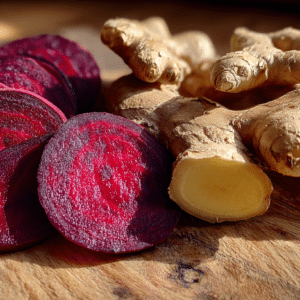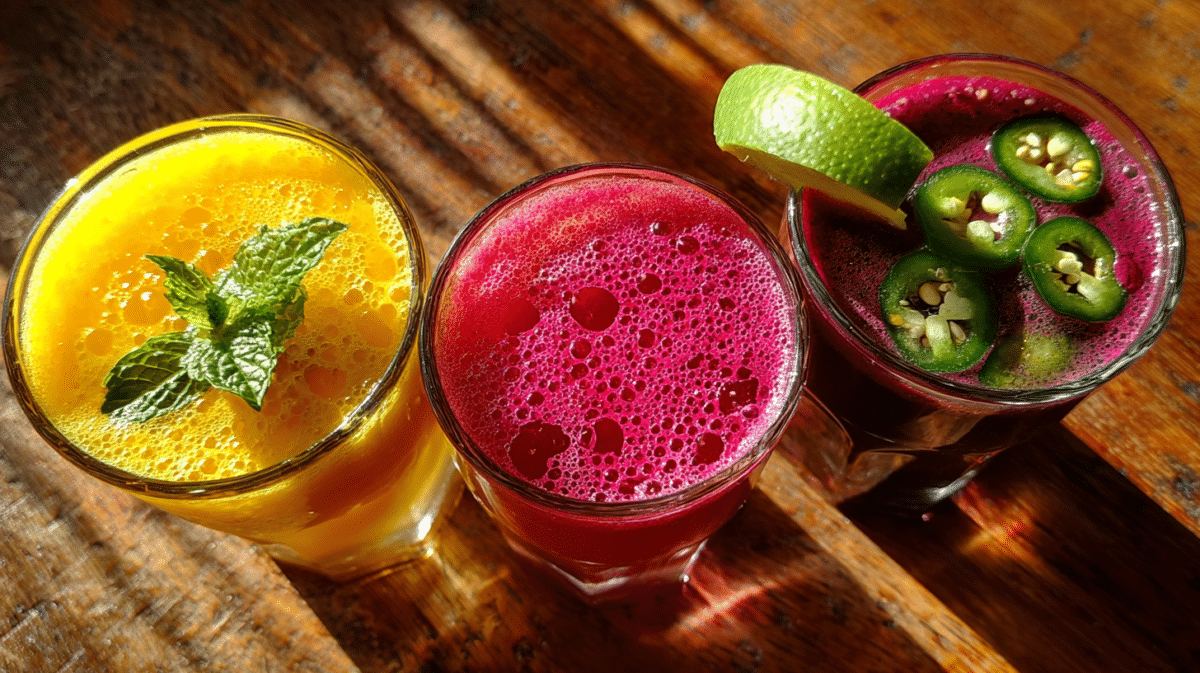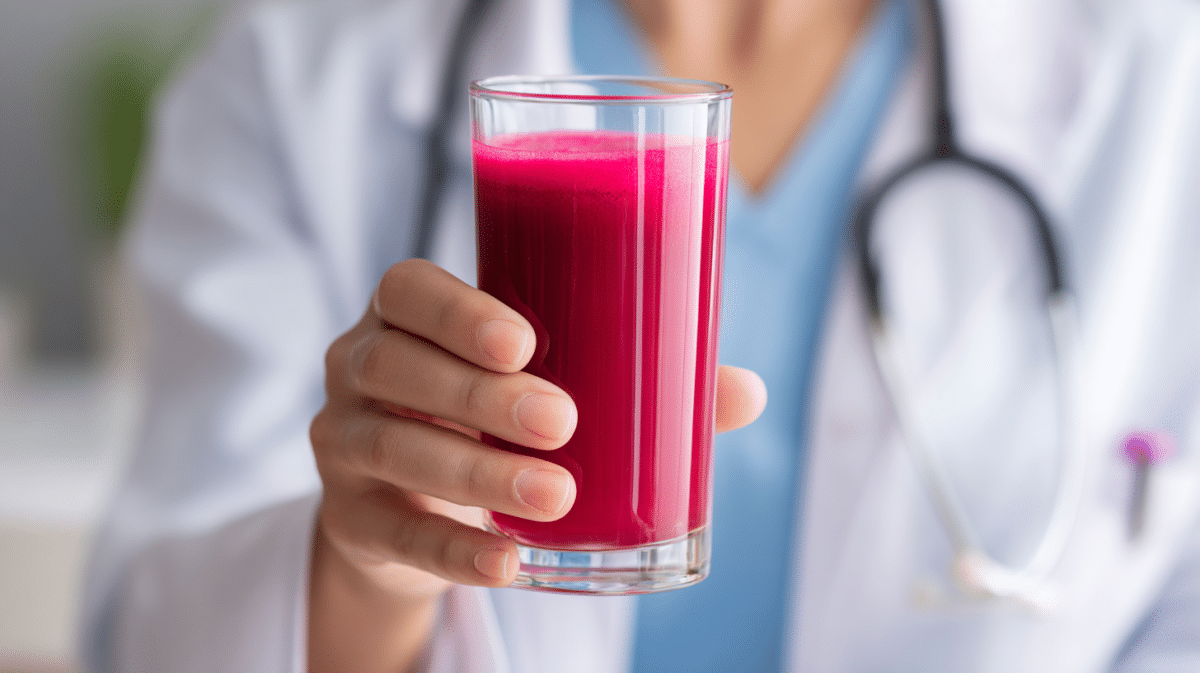Looking for a natural drink that boosts energy, supports your heart, and kicks inflammation to the curb? Ginger-Beet Juice might just be the super drink your wellness routine needs. This vibrant blend of earth-sweet beets and zingy ginger isn’t just trendy—it’s backed by nutrition science. Whether you’re sipping for a morning detox, prepping for a workout, or chasing better blood pressure numbers, this juice has you covered.

In this article, we’ll dive into the real, research-backed benefits of Ginger-Beet Juice, break down ingredients that elevate its health impact, and show you exactly how to make it—even without a juicer. You’ll also discover powerful add-ins like turmeric, kale, or lemon, and learn how this drink stacks up against other wellness beverages like mushroom coffee and herbal tonics.
Check out our deep dive on Mediterranean drinks and their health benefits for more beverage inspiration.
Let’s get started with why this crimson tonic is turning heads in both kitchens and clinical research labs.
PART 1: Ginger-Beet Juice Benefits Backed by Science
Beetroot and Ginger: A Nutritional Powerhouse
Beetroot is rich in nitrates, compounds that convert into nitric oxide in the body—helping to dilate blood vessels and improve blood flow. These vascular benefits are directly tied to lower blood pressure and enhanced oxygen delivery to muscles, according to a clinical study from the NIH.
Meanwhile, ginger is renowned for its potent anti-inflammatory and digestive-supportive properties. It contains gingerol, a natural compound shown to reduce oxidative stress, ease nausea, and support metabolic function. Together, ginger and beetroot create a powerful synergy that targets inflammation, heart health, and energy at once.
The Role of Nitrates and Antioxidants in Heart Health
Beets contain betalains, vibrant pigments with antioxidant and anti-inflammatory effects. These pigments are what give Ginger-Beet Juice its striking hue—and its disease-fighting potential. When consumed regularly, beet juice can reduce inflammation markers, lower systolic blood pressure, and improve endothelial function. These effects are particularly valuable for individuals at risk of cardiovascular disease or those seeking to maintain optimal blood pressure.
Ginger supports heart health by reducing blood clotting risk and improving cholesterol levels. Studies suggest that combining beetroot and ginger amplifies nitric oxide production, which further benefits circulation and oxygen transport.
Looking for more about health drinks and circulatory support? Discover the benefits of hibiscus tea, another antioxidant-rich option.
Evidence-Based Benefits from Clinical Studies
Clinical studies have confirmed that Ginger-Beet Juice:
| Benefit | Supporting Ingredient | Research Insight |
|---|---|---|
| Lowers blood pressure | Beetroot (nitrates) | Improves arterial dilation (NIH study) |
| Boosts immunity | Ginger & Kale | Rich in Vitamin C and antioxidants |
| Reduces inflammation | Ginger & Turmeric (if added) | Blocks inflammatory pathways |
| Enhances exercise performance | Beets | Improves stamina and oxygen use |
| Aids digestion | Ginger | Stimulates bile production and gut mobility |
These aren’t just health fads. They’re grounded in nutritional biochemistry and endorsed by scientific journals and dietitians alike.
Check out this deep guide on the benefits of mushroom coffee to compare other functional drinks in your daily routine.

Ginger-Beet Juice: The Ultimate Antioxidant Power Drink for Wellness & Energy
Equipment
- 1 Blender High-speed blender preferred
- 1 Fine-mesh sieve or cheesecloth For straining juice
- 1 Knife For chopping ingredients
- 1 Cutting board For prepping produce
Ingredients
- Amount Unit Name Notes
- 1 medium beet peeled and chopped
- 1 inch fresh ginger peeled
- 1 carrot peeled
- 1 apple cored leave skin on if desired
- ½ orange peeled and seeds removed
- ¼ tsp turmeric optional fresh or powdered
- ½ cup water adjust for desired consistency
Instructions
- Wash and prep all fresh produce. Peel beets, ginger, and carrots. Core the apple and peel the orange.
- Chop everything into small chunks to help with blending.
- Add all ingredients into a blender, along with 1/2 cup water.
- Blend until smooth.
- Pour mixture through a fine-mesh sieve or cheesecloth into a bowl, pressing down to extract juice.
- Transfer strained juice to glasses. Enjoy fresh, or refrigerate for up to 24 hours.
PART 2: How Ginger-Beet Juice Supports Key Body Functions
Detoxification and Liver Function Support
One of the most talked-about benefits of Ginger-Beet Juice is its ability to support natural detoxification. Beets are packed with betaine and pectin, two compounds that assist the liver in flushing out toxins. Betaine specifically supports liver enzyme activity, while pectin helps bind and eliminate heavy metals and waste from the body.
Ginger, on the other hand, boosts circulation and warms the digestive tract, which may improve bile flow—critical for fat digestion and toxin release. The synergy of these two roots makes this juice a potent daily detox elixir.
If you’re looking to expand your detox lineup, don’t miss our post on Mediterranean beverages, many of which complement beet-ginger blends.
Digestive Health and Anti-Inflammatory Properties
The natural compounds in Ginger-Beet Juice work wonders for the digestive system. Ginger is widely known to stimulate gastric motility and ease bloating, while beetroot is high in dietary fiber, especially when pulp is retained in juice. This helps regulate bowel movements and fosters healthy gut bacteria.
Moreover, both ingredients possess strong anti-inflammatory effects. Ginger’s gingerol and shogaol have been shown to reduce inflammation in the gut lining, which can be beneficial for people with IBS or occasional digestive discomfort.
Turmeric is often added to enhance these effects. It contains curcumin, another well-known anti-inflammatory agent. When combined with beets and ginger, the resulting blend can reduce oxidative stress and systemic inflammation over time.
Need a fresh way to boost your gut? Check out our Greek quinoa salad with lemon and dill—a fiber-rich side that pairs perfectly with Ginger-Beet Juice.
Improved Circulation and Brain Function
Beetroot is rich in dietary nitrates, which convert into nitric oxide—a vasodilator that widens blood vessels and improves blood flow. This not only enhances oxygen transport throughout the body but also plays a role in boosting cognitive performance and mental clarity.
Drinking Ginger-Beet Juice regularly may increase oxygen delivery to the brain, enhancing focus and stamina. In athletes and older adults alike, this improved circulation can translate to sharper thinking and better endurance.
Ginger also supports microcirculation, especially in the extremities, making this drink a top choice for people who experience cold hands and feet or poor circulation due to lifestyle or aging.
Looking for more brain-boosting drinks? Explore this article on brain-supportive Mediterranean drinks.
ART 3: Ingredients That Maximize the Power of Ginger-Beet Juice
Why Carrots, Kale, and Apples Complement Beets and Ginger
If you’re serious about building a powerhouse Ginger-Beet Juice, pairing beets and ginger with the right fruits and vegetables makes all the difference. Carrots offer a natural sweetness and high levels of beta-carotene, converting into vitamin A—essential for vision and immune support. They mellow out the earthiness of beetroot without masking its nutritional strength.
Apples bring fiber, a hint of tartness, and support gut health, especially if you leave the skin on. Kale is a superfood staple for good reason: it adds vitamins C, K, and folate, which support immunity and blood cell formation.
Combined, these ingredients create a flavorful, nutrient-dense blend that enhances the natural benefits of Ginger-Beet Juice while improving taste and balance.
For more on veggie blends with nutrition in focus, check out our article on healthy Mediterranean salads.
The Citrus Advantage: Orange vs Grapefruit
Citrus fruits do more than add brightness to your juice—they play an important role in nutrient absorption. Vitamin C helps increase iron absorption from beetroot, making Ginger-Beet Juice especially beneficial for people with low iron levels or anemia.
But should you use oranges or grapefruit? Oranges are sweeter and round out the earthiness of beets, making them ideal for beginners. Grapefruit, while slightly bitter, contains naringenin, a flavonoid linked to improved metabolic health.
Just remember: grapefruit can interact with medications, especially those for cholesterol or blood pressure. When in doubt, stick to oranges or consult your doctor.
Best Spices to Boost Absorption: Turmeric, Cayenne, Paprika
A pinch of the right spice can turn your daily Ginger-Beet Juice into a supercharged elixir. Turmeric is the go-to choice, rich in curcumin, which works synergistically with ginger’s anti-inflammatory effects. Add a touch of black pepper to enhance curcumin absorption by up to 2,000%.
Cayenne stimulates metabolism and blood flow, while smoked paprika gives your juice a savory twist. These aren’t just for flavor—they’re proven to enhance digestion, lower inflammation, and increase nutrient uptake.
Looking for other creative juice combinations? Explore our roundup of Mediterranean drink pairings designed for energy and detox.
PART 4: How to Make Ginger-Beet Juice Without a Juicer
Step-by-Step Blending and Straining Method
No juicer? No problem. You can still enjoy all the benefits of Ginger-Beet Juice using a high-speed blender and a fine mesh strainer or nut milk bag. Here’s how:
- Wash and prep your ingredients. Peel the beets, ginger, and carrots. Core the apples. Remove orange peel and seeds.
- Chop into small chunks for easy blending.
- Blend with water (about ½ cup) until smooth.
- Strain through cheesecloth or mesh into a clean bowl. Press with a spoon to extract every drop.
- Pour into a glass and enjoy immediately—or chill in the fridge for up to 24 hours.
This DIY method retains pulp and fiber, which supports digestion and makes your Ginger-Beet Juice more filling.
Smart Ingredient Prep and Order of Juicing
Even if you do have a juicer, the order of ingredients matters. Start with soft items like citrus fruits or leafy greens (like kale or parsley). Follow with firm fruits (apples), and end with dense roots like beets and carrots.
This prevents clogging and ensures maximum juice yield. When using ginger or turmeric, add them mid-process so their oils integrate better with the other ingredients.
This layering technique enhances texture, improves extraction, and keeps your Ginger-Beet Juice vibrant and smooth.
Fresh vs Powdered Ginger: Which Should You Use?
Whenever possible, go with fresh ginger. It contains higher levels of gingerol, which has strong anti-nausea, antibacterial, and anti-inflammatory properties. Plus, the peppery bite of fresh root elevates the flavor of your beet juice dramatically.
If you’re out of fresh ginger, powdered ginger will work in a pinch. Use about 1/8 teaspoon per serving, and stir thoroughly.
Still unsure? Explore this article on how Mediterranean diets use spices to better understand their power in daily cooking and drinks.
PART 5: Ginger-Beet Juice Variations and Recipes
Ginger-Beet Juice with Turmeric and Lemon

Looking for an anti-inflammatory powerhouse? This Ginger-Beet Juice variation blends turmeric and lemon to amplify its benefits. Turmeric adds curcumin, known to reduce chronic inflammation, while lemon introduces vitamin C and a refreshing tang that cuts through beetroot’s earthiness.
Recipe:
- 1 medium beet
- 1-inch ginger root
- 1/2 lemon (peeled)
- 1/2 tsp fresh turmeric or a pinch of ground
- 1 apple or orange
- Optional: pinch of black pepper for curcumin absorption
This golden-red fusion is a morning favorite and works wonders post-workout for muscle recovery and hydration.
Sweet Green Beet Juice with Spinach and Basil
If you want to add a green twist to your Ginger-Beet Juice, toss in a handful of spinach and fresh basil. Spinach increases folate and magnesium, while basil brings mood-boosting properties and a burst of herbal flavor.
The combination not only balances the sweetness from the apple and carrot but also delivers a smooth finish. This version is excellent for supporting blood flow and digestion, especially when consumed on an empty stomach.
Looking for more wholesome green dishes? Discover our fiber-rich stuffed zucchini recipe to pair with your green beet juice.
Spicy Detox Juice with Jalapeño and Parsley
Add heat to your routine with this detox variation of Ginger-Beet Juice featuring jalapeño and parsley. Jalapeño offers capsaicin, which promotes metabolism, while parsley supports kidney function and helps flush excess sodium from the body.
Recipe Tip: Use just ¼ of a jalapeño to avoid overpowering the juice. Combine with beets, ginger, lemon, cucumber, and parsley for a full-body cleanse in a glass.
These recipe ideas not only expand your juicing options but also increase nutrient diversity—crucial for long-term health.
PART 6: When and How to Drink Beet-Ginger Juice for Best Results
Morning, Pre-Workout, or Post-Meal: What Works Best?
The best time to enjoy Ginger-Beet Juice depends on your goals. If you’re after energy and performance, drink it 30 minutes before exercise. The nitrates in beets enhance oxygen efficiency, while ginger primes your metabolism and helps warm the body.
For a morning cleanse, drink on an empty stomach with lemon to stimulate digestion and activate liver detox pathways. For digestive aid, drink it post-meal to reduce bloating and ease gastric discomfort.
Whatever your timing, consistency is key. Regular intake of Ginger-Beet Juice supports long-term cardiovascular and metabolic health.
Storage Tips: Can You Make It Ahead?
Yes, but with caution. Ginger-Beet Juice is best consumed fresh, as oxidation reduces nutrient levels over time. If you must store it, follow these tips:
| Tip | Benefit |
|---|---|
| Use airtight glass jars | Reduces air exposure |
| Fill to the brim | Limits oxidation |
| Add lemon or lime | Natural preservative |
| Refrigerate immediately | Maintains freshness |
Consume within 24–36 hours for optimal flavor and health effects. Shake before drinking, especially if pulp or spices are included.
Want more ways to enjoy wellness drinks fresh? See how our Mediterranean beverage tips preserve flavor and nutrients.
Should You Drink It on an Empty Stomach?
Drinking Ginger-Beet Juice on an empty stomach maximizes nutrient absorption and kickstarts digestion. The liver and kidneys process nutrients more efficiently without competition from other foods, making it ideal for detox or energy-boosting purposes.
However, individuals with sensitive stomachs might prefer drinking it with a small meal or snack to avoid mild nausea from the ginger or acidity.
PART 7: Ginger-Beet Juice and Common Health Conditions
Juice for Blood Pressure and Cardiovascular Health
One of the most compelling reasons people turn to Ginger-Beet Juice is its clinically backed potential to lower blood pressure. This effect comes primarily from the dietary nitrates found in beetroot. These nitrates are converted into nitric oxide, which relaxes and dilates blood vessels, improving blood flow and reducing strain on the heart.
Clinical studies, such as the one published by the National Institutes of Health (NIH), confirm that beet juice can significantly reduce systolic and diastolic pressure after just a few hours of consumption. Ginger supports this process by improving circulation and acting as a natural anti-coagulant.
Together, the components in Ginger-Beet Juice create a functional drink ideal for people managing hypertension or seeking heart-healthy routines.
Managing Inflammation, Arthritis, and Joint Pain
Chronic inflammation is a leading factor in arthritis, joint pain, and even autoimmune disorders. The combination of gingerol from ginger and betalains from beets makes Ginger-Beet Juice a powerful anti-inflammatory drink. It works by reducing pro-inflammatory cytokines that contribute to swelling and joint discomfort.
Add turmeric to the mix, and you’ll enhance its effect even more. Many people with arthritis report reduced stiffness and improved mobility when incorporating this juice into their morning ritual.
If you’re interested in other inflammation-fighting meals, explore this guide to Mediterranean-style drinks and soups.
Is It Safe for Diabetics and People on Medication?
Ginger-Beet Juice is generally safe for most people when consumed in moderate amounts. However, there are some precautions to consider:
- Beetroot contains natural sugars, which can slightly spike blood glucose. Those with diabetes should monitor their levels closely and combine the juice with a high-fiber or protein-rich meal.
- Ginger may interact with blood-thinning medications (e.g., warfarin) and affect blood pressure or glucose medication dosage.
- Grapefruit juice (if used) can interfere with statins and other drugs.
If you’re on medication, consult your physician before making this juice a daily habit.
Want to dive deeper into ingredient safety? Here’s a great resource on how mushroom coffee compares in terms of medicinal effects.
PART 8: Expert Opinions and Scientific Research on Beet Juice
What the NIH and Other Journals Say About Beet Juice

The scientific community has taken a strong interest in beetroot and ginger—particularly when combined in drinks like Ginger-Beet Juice. According to the NIH study on beetroot supplementation, consuming beet juice led to improved vascular endothelial function, reduced blood pressure, and enhanced stamina in healthy adults and athletes.
Another study published in the Journal of Nutrition and Metabolism highlighted the nitric oxide-boosting effect of beets and how it enhances blood flow to the brain and muscles.
This confirms what many health professionals already recommend: drinking Ginger-Beet Juice regularly can be an effective natural strategy for cardiovascular support, stamina, and recovery.
Functional Foods: Where Beet Juice Stands
Beetroot juice is considered a functional food, meaning it provides health benefits beyond basic nutrition. It’s grouped with other superfoods like turmeric, ginger, kale, and berries—all known for their bioactive compounds.
The presence of betalains, polyphenols, and essential vitamins makes Ginger-Beet Juice a highly concentrated source of phytonutrients. These compounds not only fight inflammation but also support immune defense, detoxification, and cellular repair.
If you’re curious about other functional drinks and how they compare, our Mediterranean beverage collection offers more juice and tea options.
Insights from Nutritionists and Wellness Practitioners
Registered dietitians often recommend Ginger-Beet Juice to clients seeking natural ways to manage fatigue, inflammation, and metabolic sluggishness. It’s particularly popular among athletes, yogis, and health-conscious professionals looking for clean, plant-based energy.
Here’s what experts suggest:
- Drink it early for maximum detox benefits
- Pair with exercise to amplify oxygen use
- Rotate with green juices to diversify nutrients
For deeper insights into wellness routines, check out our post on daily Mediterranean habits.
PART 9: Ginger-Beet Juice vs Other Functional Drinks
Ginger-Beet vs Green Juice: Which Is Healthier?
Green juices, made from kale, celery, spinach, and cucumber, are famous for their detox properties. But when it comes to oxygen delivery, stamina, and circulation, Ginger-Beet Juice has the upper hand. Thanks to its high nitrate content, beetroot boosts nitric oxide levels more effectively than most greens.
Green juice is excellent for alkalizing the body and improving digestion. However, Ginger-Beet Juice offers a unique mix of root power and anti-inflammatory herbs—making it more beneficial for heart health, endurance, and inflammation reduction.
For those who enjoy green drinks, blending the two can be even more powerful. Try adding spinach or kale to your beet juice for the best of both worlds.
Beet Juice vs Turmeric Shots: Anti-Inflammatory Showdown
Turmeric shots are small but mighty, often containing black pepper, lemon, and cayenne. They’re excellent for reducing inflammation and improving immunity.
But turmeric alone doesn’t offer the blood flow and oxygen-boosting effects that beetroot does. That’s where Ginger-Beet Juice wins. It’s not just anti-inflammatory—it’s also energizing and circulatory-enhancing, thanks to its nitrate and gingerol content.
Add turmeric to your beet-ginger base to build a hybrid drink that brings together the best anti-inflammatory ingredients in one glass.
How It Compares with Mushroom Coffee or Herbal Teas
Mushroom coffee, especially blends with lion’s mane or cordyceps, supports brain health and focus. Herbal teas like hibiscus, peppermint, or chamomile are calming and detoxifying.
But none deliver the vascular, digestive, and stamina-enhancing combination of Ginger-Beet Juice. It’s a functional drink that targets multiple systems at once—cardiovascular, digestive, neurological, and immune—without caffeine or processed ingredients.
Curious how these compare? Explore this deep dive into functional teas and drinks.
FAQ: People Also Ask
Ginger-Beet Juice supports heart health, lowers blood pressure, reduces inflammation, boosts stamina, and enhances digestion. Beets provide nitrates that convert to nitric oxide, improving circulation, while ginger adds anti-inflammatory and digestive benefits.
Absolutely. Ginger and beetroot not only taste great together, but their health benefits also complement each other. Ginger’s spicy kick balances beet’s earthiness, and their compounds work synergistically to improve blood flow and reduce inflammation.
Combining beets, turmeric, and ginger creates a powerful anti-inflammatory tonic. This blend supports liver detox, joint pain relief, and cardiovascular health, making it ideal for people managing arthritis, fatigue, or inflammation.
Beet juice pairs well with apples, oranges, carrots, kale, ginger, turmeric, lemon, parsley, and even jalapeños. For added benefits, you can also blend it with cucumber or spinach. Always consider your health goals and taste preferences when building your juice.
Conclusion
If you’re looking for a natural, evidence-backed way to boost energy, circulation, and immunity, Ginger-Beet Juice checks all the boxes. With its unique combination of nitrates, antioxidants, and anti-inflammatory compounds, this juice is more than a health trend—it’s a daily essential.
Whether you’re managing blood pressure, fighting inflammation, or just need a detox reset, this vibrant drink can easily fit into your routine. Its versatility in ingredients and preparation makes it ideal for anyone—from juicing beginners to wellness pros.
Don’t miss our complete guide to Mediterranean beverages that support total health for other drinks that pair well with Ginger-Beet Juice.
Table of contents
- PART 1: Ginger-Beet Juice Benefits Backed by Science
- PART 2: How Ginger-Beet Juice Supports Key Body Functions
- ART 3: Ingredients That Maximize the Power of Ginger-Beet Juice
- PART 4: How to Make Ginger-Beet Juice Without a Juicer
- PART 5: Ginger-Beet Juice Variations and Recipes
- PART 6: When and How to Drink Beet-Ginger Juice for Best Results
- PART 7: Ginger-Beet Juice and Common Health Conditions
- PART 8: Expert Opinions and Scientific Research on Beet Juice
- PART 9: Ginger-Beet Juice vs Other Functional Drinks
- FAQ: People Also Ask
- Conclusion

2 thoughts on “Ginger-Beet Juice: The Ultimate Antioxidant Power Drink for Wellness & Energy”